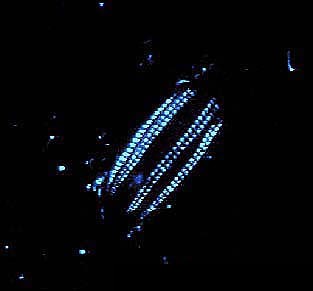
Bathocyroe is a genus of ctenophores, the only genus in the family Bathocyroidae.

Axiidae is a family of crustaceans belonging to the infraorder Axiidea, within the order Decapoda.
Lyrocteis is a genus of benthic comb jellies. It is the only genus in the monotypic family Lyroctenidae.
Eurhamphaeidae is a family of ctenophores.

The Macrophthalmidae, commonly referred to as sentinel crabs, are a family of crabs, comprising these subfamilies and genera:

Leucothea is a genus of ctenophores in the monotypic family Leucotheidae.

The Venus girdle is a comb jelly in the family Cestidae. It is the only member of its genus, Cestum, and is also the largest of all known ctenophores.

Beroe, commonly known as the cigar comb jellies, is a genus of comb jellies in the family Beroidae. Beroe exhibits bioluminescence.
Coeloplana loyai is a species of benthic comb jelly. It is known from the Red Sea and lives as an episymbiont on the mushroom corals Herpolitha limax and Ctenactis echinata. It can be differentiated from congeneric species by their host, colour, and colour pattern.
Coeloplana yulianicorum is a species of benthic comb jelly. It is known from the Red Sea and lives as an episymbiont on the soft coral Sarcophyton yulianicorum. It can be differentiated from congeneric species by their host, colour, and colour pattern.
Coeloplana huchonae is a species of benthic comb jelly. It is known from the Red Sea and lives as an episymbiont on the stems of the soft coral Dendronephthya hemprichi. It can be differentiated from its congeneric species by their host, colour, and colour pattern.
Coeloplana fishelsoni is a species of benthic comb jelly. It is known from the Red Sea and lives as an episymbiont on colonies of Xenia umbellata and Paralemnalia species. It can be differentiated from its congeneric species by their host, colour, and colour pattern.
Deiopea kaloktenota is a species of ctenophore in the family Eurhamphaeidae. It is the only species in the monotypic genus Deiopea.
Velamen is a genus of ctenophores belonging to the family Cestidae. It contains a single species, Velamen parallelum. The species is less than 20 cm long on average.
Aulacoctena is a monotypic genus of ctenophores belonging to the monotypic family Aulacoctenidae. The only species is Aulacoctena acuminata.

Euplokamis is a genus of ctenophores, or comb jellies, belonging to the monotypic family Euplokamididae. It shares the common name sea gooseberry with species of the genus Pleurobrachia. Despite living for hundreds of millions of years in marine environments, there is minimal research regarding Euplokamis, because they are uncommon. Research on the evolution of the basic body structures of diploblastic metazoans revealed that there are four major phyla, including the Ctenophores. Although the morphology of Euplokamis often resembles the medusa stage of Cnidarians, their eight rows of combs are one distinguishing feature that led to the official classification of Ctenophores. After being originally described by Chun (1879), the family Euplokamididae was expanded by Mills (1987) due to the discovery of a new species, Euplokamis dunlapae. Further research indicated that Euplokamis should be identified from Mertensiidae due to the rows of combs and some compression. They may also be distinguished from the genus Pleurobrachia due to their more elongated shape. Additionally, various adaptations of Euplokamis have been observed such as the use of tentacles for movement/feeding, a complex nervous system, and bioluminescent capabilities. Other characteristics including a defined mesoderm, lack of stinging cells, developmental differences, and symmetry supported the reclassification of these organisms.
Tjalfiellidae is a family of ctenophores belonging to the order Platyctenida.

Chasmocarcinidae is a family of crustaceans belonging to the order Decapoda.
Pagurus proximus is a species of hermit crab within the family Paguridae. Occurrences of the species have been made from China, South Korea, and Japan, with the holotype of the species being from Miyako Bay.

Coeloplana meteoris, is a species of benthic comb jelly native to the Indo-Pacific region that has also been found in the Arabian-Persian gulf.








